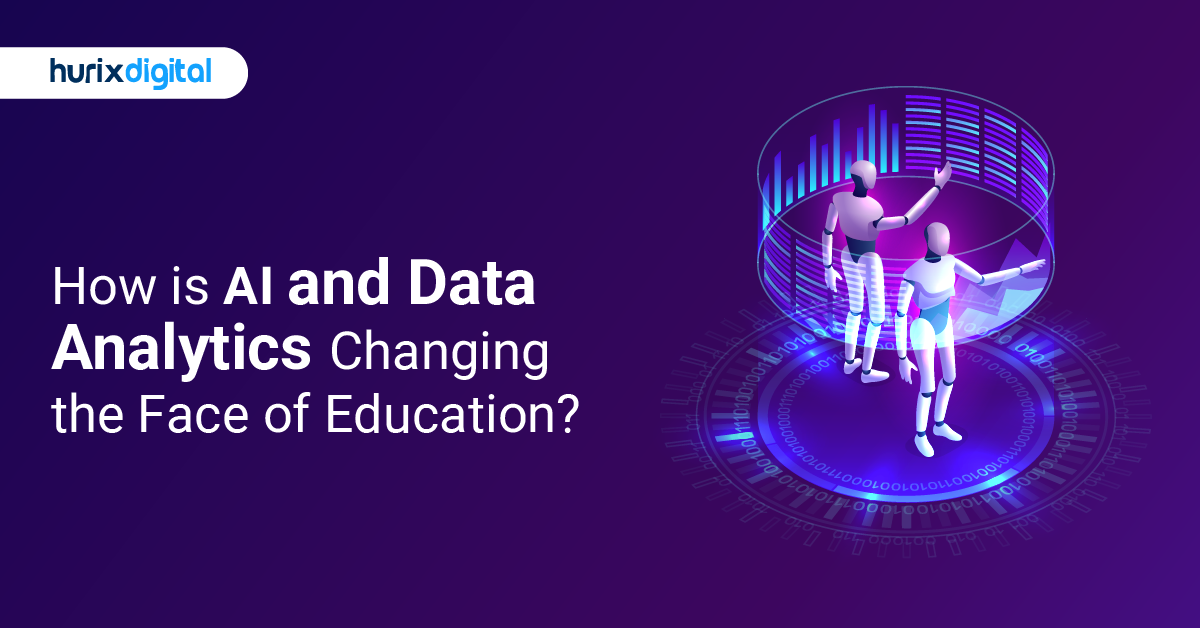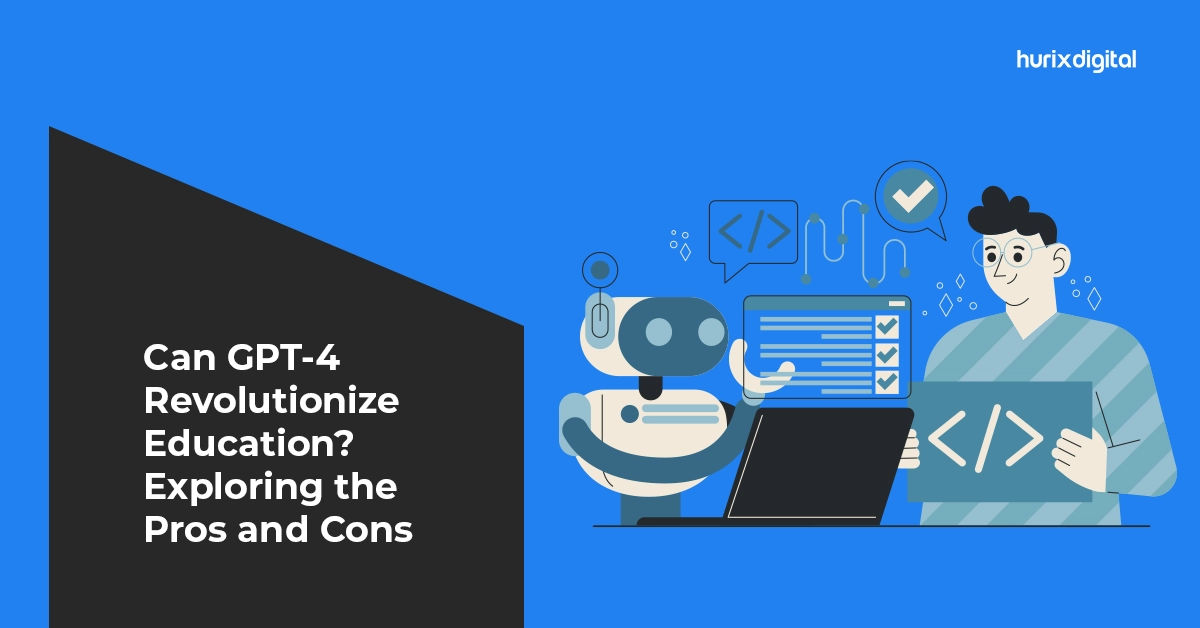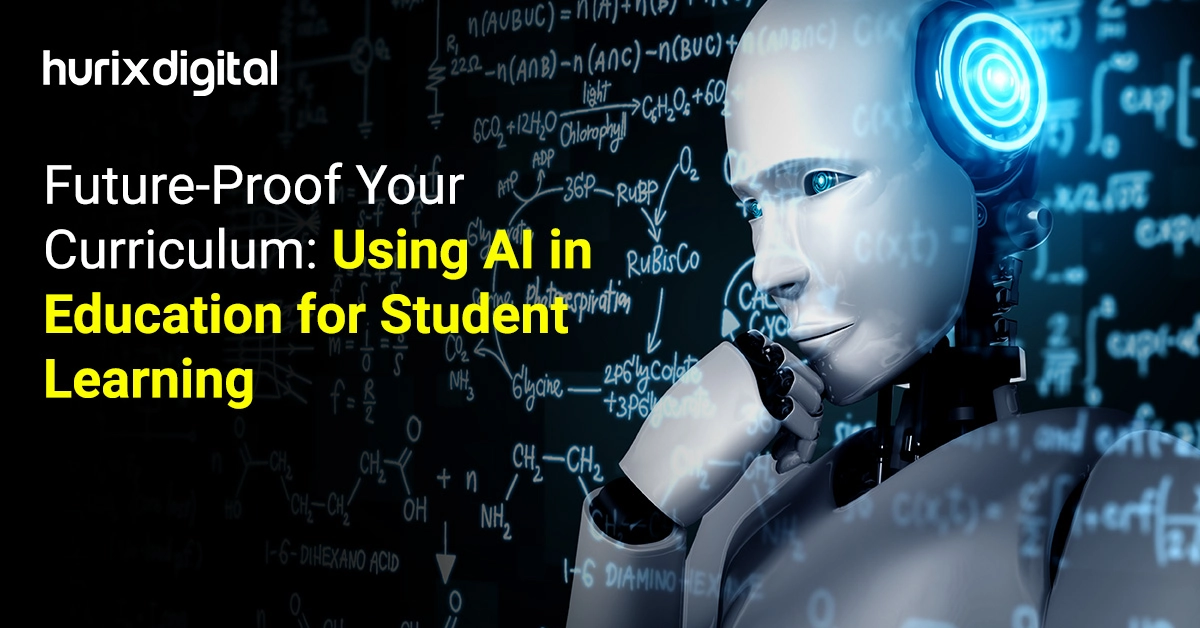
Generative AI for Assessments: Opportunities, Benefits, and Challenges
Summarize with:
With technology growing exponentially, generative AI has the potential to revolutionize the way universities evaluate student learning. Generative AI for assessments allows instructors to develop tailored assessments and scaffold learning.
On the flip side, students can misuse AI tools to shortcut valuable steps in the learning process. There are also concerns regarding integrity, authenticity, and bias in the use of these tools.
There is an ongoing debate about whether generative AI tools for students are game-changers or powerful tools that can be misused. Whichever side of the argument you are on, we can’t deny that the integration of generative AI tools in assessment has immense potential.
With the generative AI market expected to grow at a compound annual growth rate (CAGR) of 76.9%, the AI market in education is projected to reach a staggering $80 billion by 2032.
This article examines the possibilities that generative AI unlocks and its impact on assessment. Let’s get started!
Table of Contents:
- What is Generative AI?
- Should Students Use Generative AI Tools in Assessments?
- Challenges Presented by the Use of Generative AI in Assessments
- The Benefits of Generative AI in Online Assessments
- Advantages of Using Generative AI for Assessments
- Personalizes Assessments
- Generates a Range of Assessments
- Helps in Formulating Assessment Rubrics
- Gamifies the Assessment Experience
- Curates Engaging Assessments Based on Situational Context
- Increases the Frequency of Assessments
- Automates Grading of Assessments
- Reduces Bias in Assessment-Checking
- Provides Quality Assessment Analytics
- Delivers Feedback Quickly
- Generative Artificial Intelligence & Academic Integrity Concerns
- Using Generative AI Tools to Create Personalized Assessments
- Generational AI-Assisted Grading – Is This the Future?
- Wrapping Up!
What is Generative AI?
Generative artificial intelligence (AI) is a type of AI technology that creates novel outputs or data by analyzing existing content. The input data can be in the form of animations, images, text, videos, code, or music.
AI-powered systems are trained on large amounts of data to learn from the structure and then replicate the pattern uniquely. ChatGPT is the most famous example here. The tool utilizes a Large Language Model (LLM), which was trained on tens of billions of words.
Being exposed to such vast textual data, the tool can now write poems, have natural human-like conversations, and more.
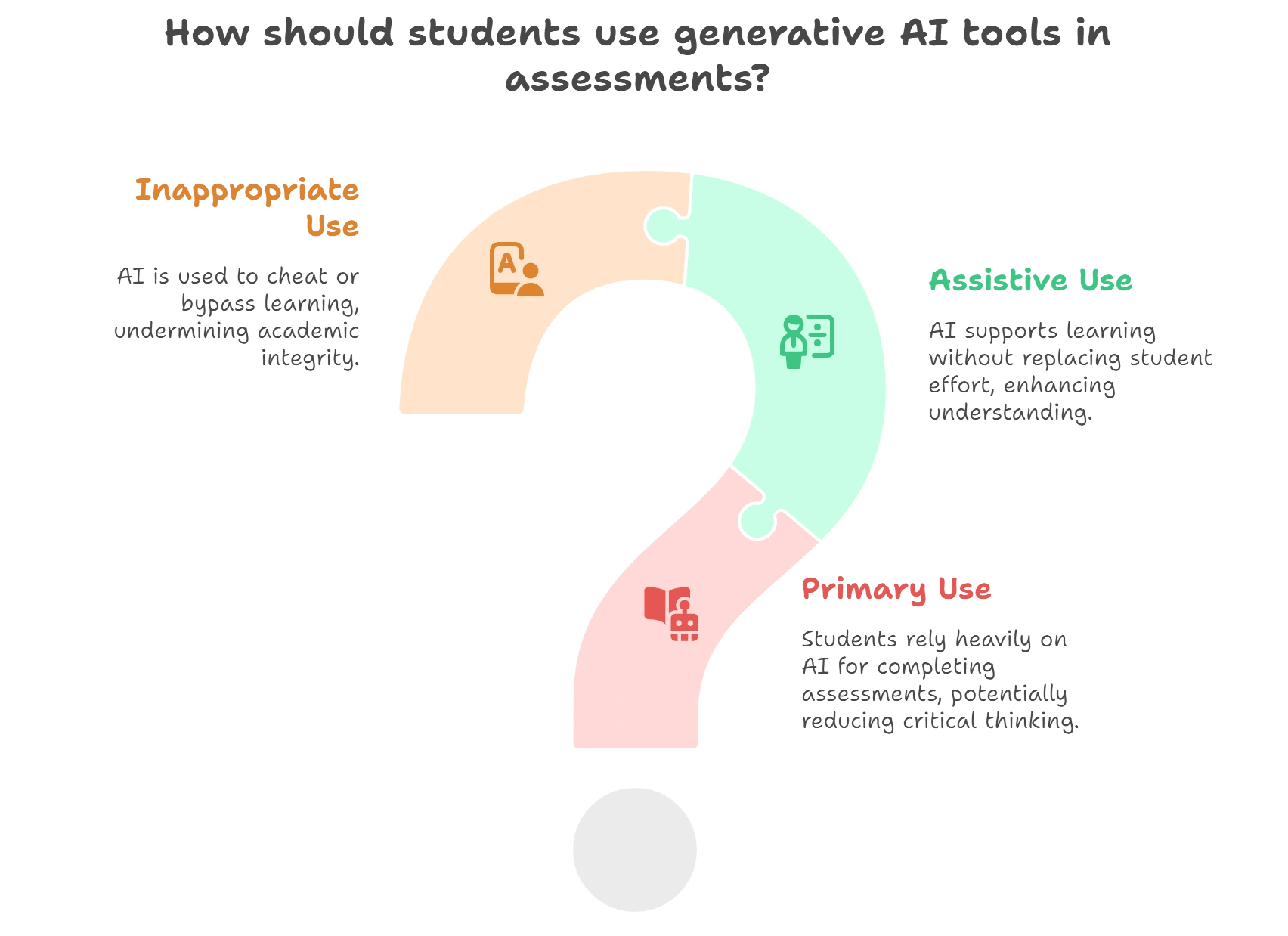
Should Students Use Generative AI Tools in Assessments?
The easy availability of AI tools raises the burning issue that students will ‘outsource’ their assessment to AI. However, the use of generative AI in assessment does not naturally constitute academic misconduct.
Students must seek guidance from instructors on what is and is not acceptable. Below are three categories of AI use in assessment that can help students optimize, instead of damage, their learning.
1. Using AI as Primary Tools
Students can use generative AI tools to generate creative solutions, tackle complex problems, and make informed judgments.
Using AI tools as an integral part of the assessment allows them to demonstrate responsible and effective use of AI.
2. Using AI as Assistive Tools
Students can use AI tools for certain defined processes within the assessment, such as pattern recognition, data analysis, or generating insights.
Here, AI tools help enhance the development of specific skills, but their use is not in itself a learning outcome.
3. Inappropriate Use of AI Tools
The use of AI in assessments that require the demonstration of foundation-level skills is wholly inappropriate.
These skills might include remembering, understanding, applying knowledge, or independently developing critical thinking skills. Examples of such assessments include class tests, vivas, online tests, and more.

Challenges Presented by the Use of Generative AI in Assessments
Now that you know the benefits of AI in education, it’s time to become aware of the various challenges associated with using generative AI tools.
According to research, the key issues often cited with the use of GenAI tools like ChatGPT include plagiarism and the threat to content accuracy and reliability.
Let’s explore these issues and some other challenges in detail.
1. Threat to Academic Integrity
Students can use AI text generator tools to come up with answers for assessments.
Since GenAI tools pick content from the internet, the possibility of the content generated by them and subsequently used by students being plagiarized is quite high. In addition, the content generated can sometimes be inaccurate or misleading.
Thus, GenAI tools end up propagating unethical use of authored content without proper citations and sometimes inaccurate and unreliable content, thereby posing a serious threat to academic integrity.
2. Perpetuation of Biases
GenAI tools are trained on large sets of data. If the data contains biases, AI-generated text will also contain biases. This means that the questions for assessments produced by GenAI tools will be biased.
Alternatively, if students use GenAI tools to complete assessments, their responses will also be biased. Thus, GenAI tools perpetuate biases in educational institutions.
3. Lack of Data Privacy
GenAI systems often require and store data about students’ academic performance, learning styles, and behavioral patterns. However, these systems can be easily hacked and leak sensitive information about students.
This raises concerns about a lack of data privacy and strengthens the need to take strong protective measures early on.
4. Limit the Development of Essential Skills
AI-generated text provides quick solutions to assessment-based questions.
Over-reliance on this easy way of completing assessments can negatively impact students’ higher-order thinking abilities and limit the development of essential skills like critical thinking, problem-solving, and more.
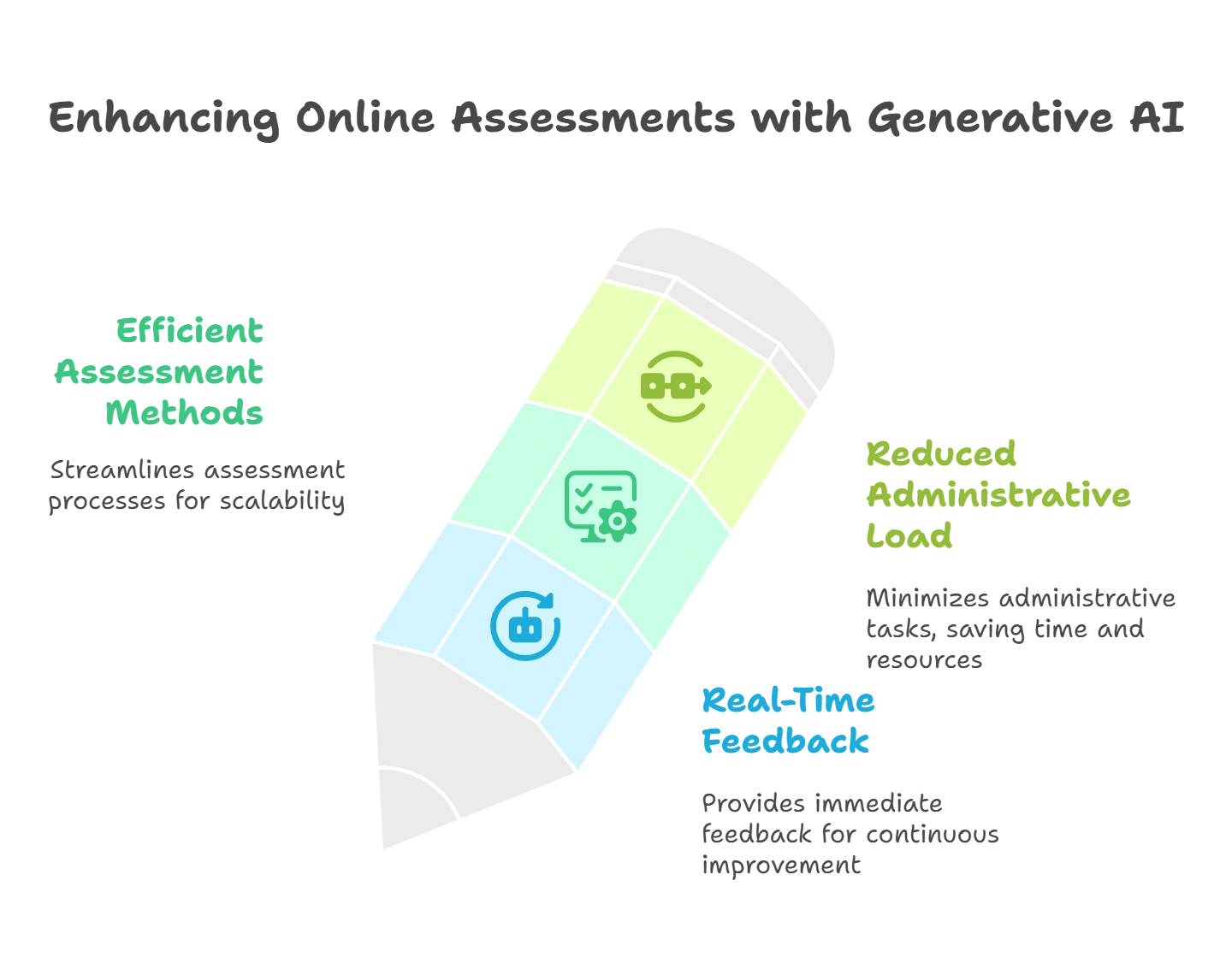
The Benefits of Generative AI in Online Assessments
In recent years, generative AI assessments online have emerged as a powerful force for change in education, enhancing traditional methods and providing flexible, personalized, and effective evaluation tools. As an instructor, embracing these advancements can offer a range of benefits that transform how you assess student performance. Understanding the advantages of AI-driven technologies helps you stay at the top of education innovation, providing students with fairer and more efficient evaluation methods.
1. Real-Time Feedback for Continuous Improvement
Feedback often arrives after an extended delay, potentially limiting its effectiveness. With generative AI assessment tools, students can receive instant results highlighting their strengths, identifying mistakes, and offering improvement tips. This feedback loop encourages continuous learning by allowing students to correct misconceptions and strengthen their knowledge in real-time.
For instructors, generative AI’s instant feedback is invaluable for tracking each student’s progress. By accessing detailed insights provided by the AI reports, you can identify areas where students struggle and provide timely intervention, ultimately encouraging a supportive and healthy learning environment.
2. Efficient and Scalable Assessment Methods
Manual grading can be time-consuming and prone to error in large classes or online courses with numerous students. Generative AI in assessments online offers scalable solutions for grading, allowing you to evaluate hundreds or even thousands of responses quickly and efficiently.
By automating routine grading tasks, your instructors can focus more on quality tasks and assignments. Generative AI allows you to handle large volumes of assessment without compromising quality, making it an ideal choice for high-enrollment classes and online education platforms.
3. Reduction of Administrative Load
Another key benefit of generative AI assessments is the reduction of administrative burdens. The grading and evaluation process is often time-intensive, requiring instructors to invest considerable effort in manually reviewing student responses. You can significantly reduce the time spent on these tasks by leveraging generative AI assessment tools. Automated grading and feedback systems allow you to redirect time and energy toward curriculum development, student interaction, and classroom management.
This efficiency also benefits students, who receive quicker feedback and results. Reduced administrative load enables faster grading and reporting, ensuring students don’t experience longer waiting times for assessment results.
Embracing generative AI assessment tools equips you to provide a more accurate, efficient, and supportive evaluation experience for your students. By upgrading accessibility, promoting academic integrity, and offering data-driven insights, generative AI transforms how education assesses and supports student learning.

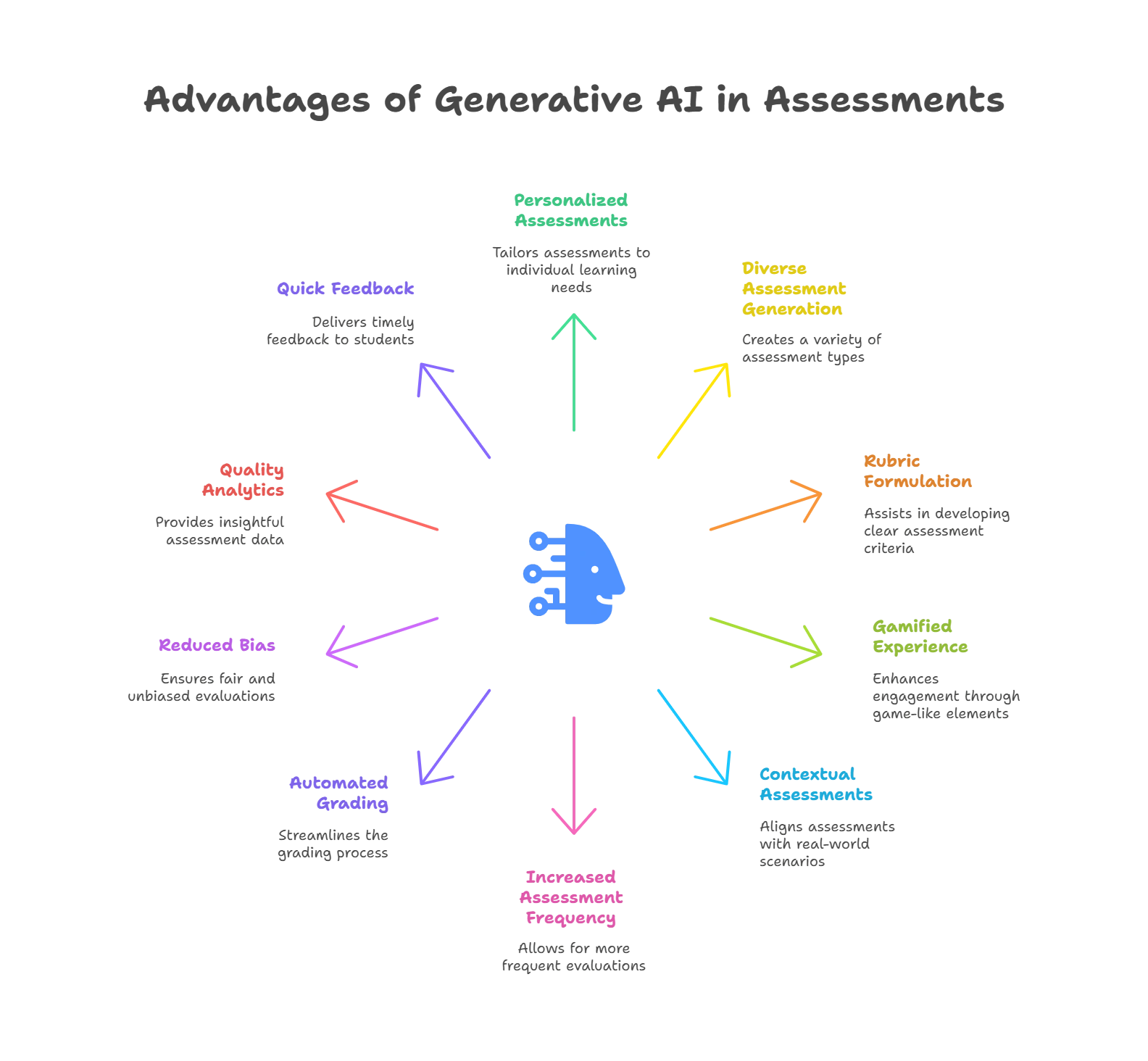
Advantages of Using Generative AI for Assessments
Generative AI models use machine learning and natural language processing algorithms to generate text, images, videos, and other forms of content.
Using generative AI assessment tools can benefit learners and educators in schools in several ways, such as the following:
1. Personalized Assessments
Traditional assessments follow a one-size-fits-all approach, neglecting to accommodate individual differences. Unlike this, generative AI takes individual differences into account and gathers information about students’ different learning needs and learning styles.
Generative AI then analyzes the gathered information and designs personalized assessments that cater to students’ different individual capabilities and proficiency levels. Thus, Generative AI makes assessments that are neither too easy nor too difficult for students to attempt, keeping them motivated throughout.
2. Generates a Range of Assessments
In a traditional assessment system, educators are restricted to assigning pen-and-paper tests to students, leaving little to no room for variety.
However, with generative AI in education, educators can develop a range of assessments for different subject matters, including math, science, language, history, coding, and more.
Educators can create a wide range of assessments, including interactive quizzes, class polls, multiple-choice questions, case studies, word clouds, projects, and more.
3. Helps in Formulating Assessment Rubrics
Teachers formulate the assessment rubrics themselves for traditional assessments. Generative AI, however, can help teachers design rubrics for a variety of assessments.
For example, with generative AI, teachers can decide the marking criteria for a project-based assessment. They can divide the marks into sections, such as regularity of check-ins at preset intervals, timely submission of the final project, level of clarity when presenting the findings, etc.
They can also decide the minimum passing marks students must score to pass the assessment.
4. Gamifies the Assessment Experience
Generative AI can make it possible for teachers to gamify the assessment-taking experience for students.
Incorporating gamification will introduce the elements of challenges and rewards in assessments. When students complete an assessment challenge, they will be rewarded with points, badges, and recognition on the leaderboard.
What’s more is that each new assessment is designed at a level above the students’ last performance, leaving scope for revision and improvement.
Thus, using gamification features in assessment will motivate students to keep studying, learning, and attempting assessments regularly.
5. Curates Engaging Assessments Based on Situational Context
Generative AI possesses the capability to create engaging assessments depending on the context of the situation. For example, generative AI can create a multiple-choice question test based on the course material covered by students in the previous class.
It can also curate a case study around a scientific phenomenon. It can also generate prompts for discussion-based assessment for different subject matters, compelling students to put on and employ their reflective and critical thinking caps.
6. Increases the Frequency of Assessments
Traditional assessment methods are pretty resource-intensive, making it difficult for teachers to conduct assessments regularly.
Unlike this, AI-powered digital assessment tools require a minimal number of resources. This makes it easily possible for teachers to increase the frequency of assessments.
Conducting assessments from time to time drives students to go through their course material regularly.
7. Automates Grading of Assessments
Generative AI tools, unlike traditional assessment methods, automate the grading of assessments. The tools do this by using automatic composition grading.
A vital generative AI application, automatic composition grading, evaluates the quality of the text, level of coherence, correctness of grammar, and many other aspects of the text.
Research reveals that GenAI tools like ChatGPT can reduce grading time, maintain consistency in scoring, and provide immediate scores and feedback to students on their writing skills.
8. Reduces Bias in Assessment-Checking
Human checking in traditional assessments can be prone to bias. Unlike this, the checking done by AI-powered digital assessment tools follows a standardized system of preset evaluatory criteria.
This means that students are evaluated based on their understanding and knowledge, irrespective of their handwriting and other external subjective factors. Generative AI assessment-checkers, thus, reduce the degree of bias that can be present in the traditional assessment system.
9. Provides Quality Assessment Analytics
With traditional assessments, educators must gather data to analyze students’ performance independently. This, however, is not the case with generative AI assessment tools.
These tools automatically generate analytical reports about students’ performance in assessments. This helps educators identify the learning gaps and areas in which students are doing well.
This information further enables them to make appropriate changes to the curriculum and improve the quality of assessments’ content.
10. Delivers Feedback Quickly
Generative AI assessment tools help educators provide quick, actionable feedback to students from time to time.
In addition, they make feedback reports accessible to students, enabling them to know their strengths and weaknesses and to customize strategies for improvement.

Generative Artificial Intelligence & Academic Integrity Concerns
Generative AI tools have the potential to generate outputs that are academic in writing style, grammatically correct, and highly relevant to the stimulus question.
Misuse of these tools in assessment is considered plagiarism or falsification. This poses a serious threat to educators seeking to safeguard academic integrity.
1. Challenges for Instructors
- Difficulty in differentiating between human-generated and AI-generated content. This threatens academic integrity in all disciplines, especially computational and text-based assignments.
- Students can learn generative AI and use it to take ‘shortcuts’ with assessments. For instance, they can jump straight to the output without developing ‘thought ownership.’
- Blurred lines between fraud, plagiarism, and cheating. Students might be involved in the fraudulent use of AI-generated content and present it as their work.
2. Championing Academic Integrity in Assessment Design
- Instructors can use forms of assessment that demonstrate thought ownership. These include oral assignments, interviews, or presentations.
- They can adapt or revise assessments to support greater ownership or personalization.
- Instructors can ask students to submit evidence of process development.
Using Generative AI Tools to Create Personalized Assessments
Personalized learning revealed the cons of “one-size-fits-all” teaching methodology, which is also good for assessment. Every student has a varied skill level and aptitude. Assessments should take cognizance of the same to evaluate each student’s skill fairly.
Conventional assessments fail to accurately test student knowledge as they’re not tailored to individual student learning outcomes. With generative AI, instructors can generate adaptive assessments personalized to each student’s level of understanding.
Generative AI algorithms adjust the difficulty of subsequent questions by analyzing data on students’ responses. This ensures that every student is appropriately challenged and accurately assessed without wasting time on materials that students already know.
In the future, assessments will automatically evolve to match the specific student’s capabilities, as generative AI tends to learn and improve over time.
Generational AI-Assisted Grading – Is This the Future?
Generative AI tools learn from data, which means they can be trained to comprehend specific grading criteria. They can effectively mark students’ work based on this comprehension.
Auto-marking through generative AI is an impartial, efficient, and reliable way of grading assessments. It eliminates the downsides of manual grading: biases, inconsistencies, and errors.
By using generative AI’s capabilities, instructors can save time and effort on administrative tasks and focus more on student interaction and personalized teaching. This improved validation of assessments paints a more accurate picture of learning outcomes, enabling instructors to make better-informed teaching decisions.
Adopting generative AI for auto-grading assessments offers various benefits to students. The most significant advantages include accurate and immediate feedback on their performance.
With the constant advancement in generative AI research, there is immense potential for more sophisticated auto-grading algorithms.
Wrapping Up!
Keeping generative AI and inclusive and ethical assessment practices in mind, educators need to rethink their assessment approaches. With the right approach, they can harness this technology’s power and prepare for the future of assessments.
With careful usage and human oversight, instructors can empower students with the necessary skills to leverage generative AI for their learning and lifelong success.
If you want to optimize your student assessment platform with the smart use of generative AI, automation, and machine learning, Hurix Digital can be your digital transformation partner! Whether you want to scale, improve performance, or optimize costs, our team of experts can help you meet all your requirements. To learn more about our services, schedule a demo with us today!
Summarize with:

Senior Vice President
Julia brings over 20 years of global experience in digital learning and business strategy. She specializes in client success, enterprise learning solutions, and driving growth through innovation, with a focus on AI, VR, and emerging technologies across diverse industry verticals.
 Upcoming Masterclass | Build an Army of Brand Evangelists using Training & Development | November 20th, 8:30 AM PDT | 11:30 AM EDT | 10:00 PM IST
Upcoming Masterclass | Build an Army of Brand Evangelists using Training & Development | November 20th, 8:30 AM PDT | 11:30 AM EDT | 10:00 PM IST

